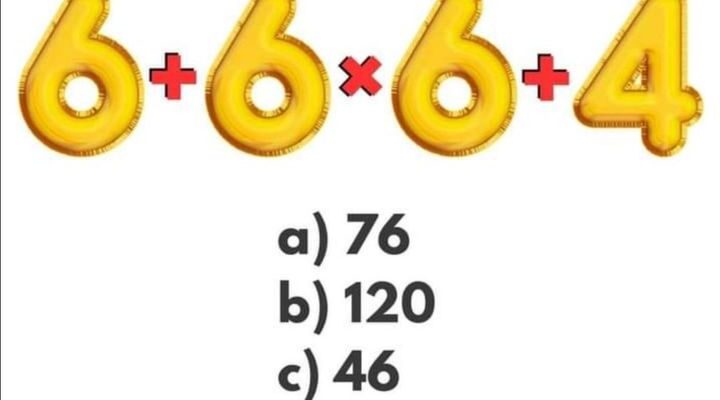A Puzzle That’s Taking the Internet by Storm
Every now and then, a riddle or puzzle comes along that captures everyone’s attention, challenging people to flex their mental muscles. The latest brain teaser making waves online has people scratching their heads, with only a select few able to solve it. The question remains: can you provide the correct answer?
What Makes a Good Puzzle?
Puzzles like this one aren’t just about testing your intelligence—they push your thinking outside the box, forcing you to consider perspectives and possibilities you wouldn’t typically explore. It’s about more than just getting the answer; it’s about the process of arriving there.
Engaging Your Critical Thinking

Puzzles tap into your critical thinking skills. They require you to analyze the information given, recognize patterns, and think logically. Unlike everyday tasks, which often rely on routine, puzzles force your brain to approach problems in new ways.
A Test of Patience
It’s not just about intelligence—puzzles require patience. You might not get the answer right away, and that’s okay! In fact, part of the fun is the journey of discovery.
The Puzzle at Hand: Can You Crack It?
Let’s get into the puzzle that’s baffling people across social media. On the surface, it seems simple, but looks can be deceiving.
Here’s the puzzle: You see a door with a numeric keypad, and a sign above that says, “The code is the same as the number of letters in this question.”
Now, take a moment. Think it through. How would you approach this?
First Step: Analyzing the Clue
At first glance, you might feel confident that the answer is obvious. But don’t let that initial impression fool you! This riddle isn’t just asking for the number of words in the question but the number of letters. It’s tempting to think too fast, but slow down and really look at the information you have.
Breaking Down the Clue
The key here is to count the letters in the question. If you count every letter in “The code is the same as the number of letters in this question,” you’ll come to the correct answer.
So, what’s the answer? It’s 45. That’s the total number of letters in the riddle. Simple, right?
Why This Puzzle is So Tricky
So, why do so many people get stumped by this puzzle? The challenge comes from how we process the information we’re given. Our brains are wired to focus on the question as a whole rather than break it down into its components. We tend to gloss over small details when we’re trying to rush toward an answer.
Overthinking vs. Simplicity
Many people fall into the trap of overthinking puzzles like this. It’s easy to assume there’s a hidden trick or a more complicated solution when, in reality, the puzzle is as straightforward as it appears. Often, the simplest approach is the right one.
Common Mistakes People Make
The most common mistake people make is thinking the puzzle is asking for the number of words rather than letters. Others might assume the question is more metaphorical, looking for a deeper meaning. But in this case, the answer is literal: count the letters, and you have your solution.
The Science Behind Puzzles and Riddles
Puzzles like this aren’t just a fun way to pass the time—they also have significant benefits for your brain. When you challenge yourself with puzzles, you’re actually giving your brain a workout.
Boosting Cognitive Function
Engaging with puzzles helps improve cognitive function. By pushing your brain to think critically and solve problems, you’re helping to maintain and even improve memory, attention, and problem-solving skills.
Improving Focus and Patience
Puzzles also teach patience. The process of figuring out a challenging riddle trains your brain to focus on details and persevere until you find the answer. This ability to concentrate for extended periods can benefit other areas of life, like work and study.
How to Approach Brain Teasers Like a Pro
The key to solving puzzles like this one is to slow down, focus on the details, and avoid overcomplicating things. Here are some tips to keep in mind when tackling tricky riddles:
Read Carefully
Always read the puzzle carefully before jumping to conclusions. The answer is usually hidden in the way the question is worded, so paying attention to the smallest details can help you crack the code.
Take Your Time
Riddles are meant to be challenging, so don’t rush. Give yourself time to think through the problem and explore different angles before settling on an answer.
Keep It Simple
When it comes to brain teasers, the simplest answer is often the right one. Avoid overcomplicating the problem and trust your instincts.
Conclusion: Did You Get It Right?
If you figured out that the correct answer to the puzzle is 45, congratulations! You’ve successfully solved a riddle that has stumped many others. If you didn’t get it right on the first try, don’t worry—puzzles like these are all about learning how to approach problems from new angles.
The next time you come across a brain teaser, remember to slow down, focus on the details, and enjoy the process of solving the puzzle. After all, it’s not just about the answer, but the fun of figuring it out!
